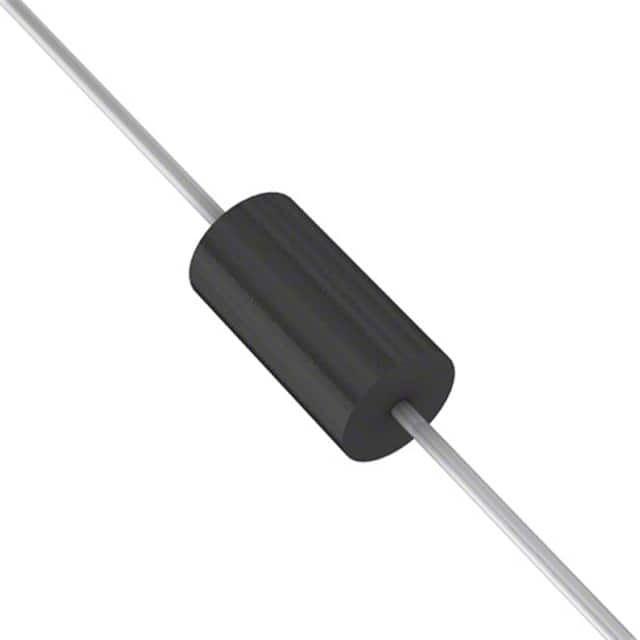2A01-T Product Overview
Introduction
The 2A01-T is a versatile electronic component that belongs to the category of diodes. This entry provides an in-depth overview of the 2A01-T, including its basic information, specifications, pin configuration, functional features, advantages and disadvantages, working principles, application field plans, and alternative models.
Basic Information Overview
- Category: Diode
- Use: Rectification and signal processing in electronic circuits
- Characteristics: High current capability, low forward voltage drop
- Package: SOD-123 package
- Essence: Semiconductor material with specific doping
- Packaging/Quantity: Typically available in reels or tubes containing multiple units
Specifications
- Maximum Forward Voltage: 1V
- Maximum Reverse Voltage: 50V
- Maximum Continuous Current: 2A
- Operating Temperature Range: -55°C to 150°C
- Storage Temperature Range: -55°C to 175°C
Detailed Pin Configuration
The 2A01-T diode has a standard SOD-123 package with two pins. The cathode is typically marked with a line on the body of the diode.
Functional Features
- Efficient rectification of alternating current (AC) to direct current (DC)
- Low forward voltage drop minimizes power loss
- Fast switching speed for signal processing applications
Advantages and Disadvantages
Advantages
- High current capability
- Low forward voltage drop
- Compact SOD-123 package
- Fast switching speed
Disadvantages
- Limited reverse voltage tolerance
- Sensitivity to temperature variations
Working Principles
The 2A01-T operates based on the principle of semiconductor junction behavior, allowing current flow in one direction while blocking it in the reverse direction. When forward-biased, it conducts current with minimal voltage drop, making it suitable for rectification and signal processing.
Detailed Application Field Plans
The 2A01-T diode finds extensive use in various electronic circuits, including: - Power supply units - Signal demodulation circuits - Voltage regulation circuits - Switching power converters - LED lighting applications
Detailed and Complete Alternative Models
Several alternative diode models can be considered as substitutes for the 2A01-T, including: - 1N4001: General-purpose rectifier diode - 1N5819: Schottky barrier diode - FR207: Fast recovery rectifier diode - MBR20100CT: Schottky rectifier
In conclusion, the 2A01-T diode offers high current capability and low forward voltage drop, making it suitable for diverse electronic applications. Its compact package and efficient performance make it a popular choice among circuit designers.
Word count: 394
Lista 10 Vanliga frågor och svar relaterade till tillämpningen av 2A01-T i tekniska lösningar
Sure, here are 10 common questions and answers related to the application of 2A01-T in technical solutions:
What is 2A01-T?
- 2A01-T is a type of aluminum alloy commonly used in technical applications due to its high strength and corrosion resistance.
What are the typical applications of 2A01-T?
- 2A01-T is often used in aerospace components, marine equipment, and structural engineering due to its excellent mechanical properties.
What are the advantages of using 2A01-T in technical solutions?
- The main advantages of using 2A01-T include its high strength-to-weight ratio, good weldability, and resistance to corrosion in various environments.
Is 2A01-T suitable for outdoor applications?
- Yes, 2A01-T is well-suited for outdoor applications due to its resistance to corrosion, making it ideal for structures and equipment exposed to the elements.
Can 2A01-T be machined easily?
- Yes, 2A01-T can be machined relatively easily, allowing for the production of complex components and parts with tight tolerances.
Does 2A01-T require any special surface treatment?
- While not mandatory, surface treatments such as anodizing or painting can further enhance the corrosion resistance and appearance of 2A01-T components.
What are the temperature limitations of 2A01-T?
- 2A01-T has good thermal stability and can be used in applications where temperatures range from -50°C to 150°C without significant loss of mechanical properties.
Is 2A01-T compatible with other materials in technical assemblies?
- Yes, 2A01-T can be easily integrated with other materials such as steel, titanium, and composites, making it versatile for use in multi-material assemblies.
Are there any specific design considerations when using 2A01-T?
- Designers should consider the material's high strength and low density when designing components to fully leverage its performance benefits.
What are the best practices for joining 2A01-T components?
- Welding, riveting, and adhesive bonding are common methods for joining 2A01-T components, with proper consideration given to minimizing distortion and preserving material properties during fabrication.
I hope these questions and answers provide a comprehensive overview of the application of 2A01-T in technical solutions. If you have any more specific questions, feel free to ask!


